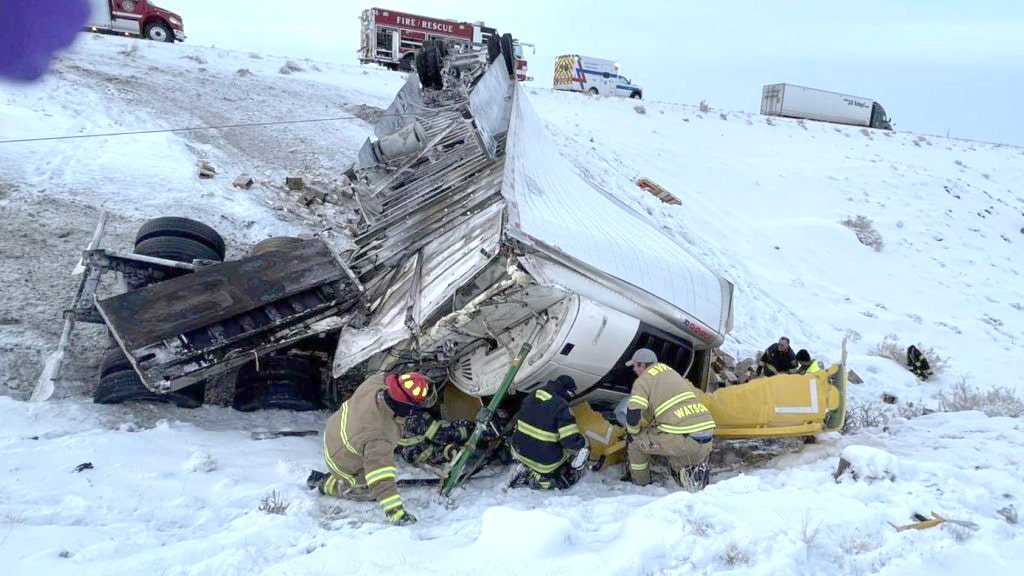Wyoming is at or near the top of vehicle crash deaths in some grim categories, including number of deaths per 100,000 population and fatal single-vehicle wrecks, according to a highway safety advocacy group.
And 2023 is shaping up to be a bad year.
As of Wednesday, the year-to-date death toll was 31, the Wyoming Highway Patrol reports. That compares to 16 on the same date last year, 19 in 2021 and 13 in 2020. The year-to-date death toll was in 2019 was worse at 34.
The year started off with one of the worst highway tragedies in recent memories Jan. 22, when Utah resident Author Nelson, 57, drove the wrong direction on Interstate 80 in Carbon County just east of Rawlins, causing a chain reaction that killed five people and critically injured another.
High Deaths Per 100,000
In 2020, Wyoming had the second-highest number of vehicle deaths per 100,000 people, or 22, according to the latest report from the Insurance Institute for Highway Safety. That compares to a nationwide figure of 11.7 vehicle death per 100,000 people. Mississippi led that year with 25.4 deaths per 100,000.
Wyoming had 114 crashes involving fatalities in 2020, with 127 total deaths, according to the report. Nationwide that year, 35,766 fatal crashes caused 38,824 deaths.
How Accurate Are The Figures?
That count could be skewed, Wyoming Department of Transportation spokeswoman Jordan Achs told Cowboy State Daily.
“We have a low population to begin with, and we also get a lot of ‘pass-through’ traffic from residents of other states because of the three Interstate highways (I-80, I-90 and I-25),” she said.
“With our small population, if we have an additional 25 fatalities in a year, that can jump our fatality rate a quarter above what it was the previous year,” Achs added. “It can be easy for us to jump to the bottom or the top of those statistics because of our small population and the sheer amount of miles that Wyomingites drive, including long commutes to work for many of us.”
Miles Driven, Types Of Vehicles
When looked at through the lens of miles driven, Wyoming’s figures look comparatively better, according to the report.
The Cowboy State had 1.3 deaths per 100 million total vehicle miles traveled, which is below the national rate of 1.34 deaths in that category.
As far as vehicles involved, the report indicates that, as one might expect, Wyomingites drive larger vehicles.
Car crashes killed 27 people in Wyoming in 2020, the reports says. Wrecks involving pickups or sport-utility vehicles killed 67, while seven were killed in crashes involving large cargo trucks. Motorcycle crashes killed 19, while six pedestrians and one bicyclist were also killed.
More Than Average Single-Vehicle, Rural Crashes
“Single-vehicle rollovers are the most common type of crash in Wyoming,” Achs said.
And the report’s numbers for 2020 bear that out. There were 76 single-vehicle crashes that resulted in deaths that year, or 60% of all fatal crashes.
Nationwide, single-vehicle wrecks accounted for 55% of fatal crashes. Rhode Island had more than any other state, with 47 single-vehicle crashes accounting for 70% of that state’s fatal vehicle crashes.
Wyoming, Montana and Idaho also topped the list for the highest percentage of fatal crashes in rural areas. Wyoming and Montana both had 80% of their vehicle fatalities happen on rural highways, while Idaho had 78%.
Poor Safety Ratings
The Insurance Institute for Highway Safety gave Wyoming – as well as surrounding states, a bottom-rung rating for safety policies. That was based on states’ seat belt and motorcycle helmet laws.
Wyoming doesn’t require helmets for adult riders and also treats not wearing a seat belt as a secondary offence. That means if a driver is pulled over for any other reason, an officer can issue fines for any vehicle occupants not wearing seat belts. Those fines are $25 for the driver and $10 for each passenger age 9 or older. The fine is $50 for each passenger age 8 or younger that isn’t properly restrained.
In 2020, 47% of the people killed in crashes were wearing a seat belt or in a child restraint, whereas 49% were not, according the report. In 3% of Wyoming’s fatalities, it was unknown whether the victim had been in a seat belt or child restraint.
Nationwide, those figures were 44% of people killed had been restrained, 46% not and 10 % unknown.
Drunken Driving
When it comes to drunk drivers killing themselves, Wyoming isn’t much above average, according to the report, but Hawaii was abysmal.
In Wyoming, 42 of 69 drivers killed in 2020, or 61% had a blood-alcohol content (BAC) of 0.08% or more. That’s compares to 29 of 30, or 97% in Hawaii, 11 of 12 (92%) in the District of Columbia and 10,543 of 18,261 nationwide, or 58%.
Trying To Make Things Safer
WYDOT tries to identify hot spots for crashes and takes steps to make them safer, Achs said.
“Do we need to add a guardrail here, or put in better reflective striping there?” she said.
Some recent or pending WYDOT safety projects include widening road shoulders, clearing timber near the roadway and adding a wildlife underpass over Togwotee Pass between 2006 and 2014, she said.
An ongoing “winter freight project” aims to improve the notorious section of I-80 between Rawlins and Laramie, she added. That includes adding hill climbing lanes for large trucks at Halleck Ridge and Cooper Cove, as well as adding additional pull-off parking for trucks along that stretch of interstate.
WYDOT also recently added a traffic signal at the intersection of Yellowstone and Four Mile in Cheyenne, she said.
“That kind of project is common in many cities and towns,” Achs said, adding that “another example is a WYDOT traffic signal at the intersection of Third and Flint streets in Laramie.”





